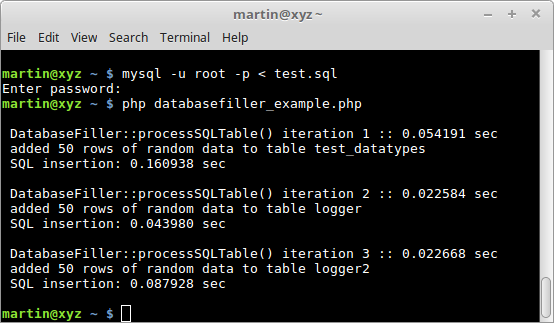This repo is shoved into retirement. The schema file parsing and single-threaded nature of PHP, along with high memory usage makes this package obsolete.
More efficient alternatives are MySQL-Filler and mysql_random_data_load.
- Database table population without using any real or sensitive data:
- Schema design and development:
- Check table field population with specified datatypes, potential data truncation etc.
- Test connection encoding and character encoding, and data insertion speeds.
Originally, I needed to populate a database containing 14 complex tables. Tools such as Spawner are ideal for populating small tables, but in this case, specifying the datatypes for 300+ fields to initiate Spawner would have been insanity.
Instead, why not parse the SQL schema?
- The script expects the database schema to already exist in MySQL (
mysql -u root -p < test.sql). - All table names and column names in the MySQL schema require back-ticks.
- Unique keys must be removed from tables when the configuration array option random_data is set to false.
- The majority of MySQL datatypes are supported.
- Any foreign keys are disabled on data population.
- Random character generation is slow in PHP, and such slowness further depends on field length, number of fields, and the number of rows being generated.
- Multiple INSERTs are added in a single query, which is quite fast. The number of INSERTs per second will depend on MySQL configuration settings (the defaults are not optimised), datatype / length inserted, system load, operating system, hardware etc.
Configuration boolean toggles (false by default):
- incremental_ints
- make added integers incremental, enabling simplistic integer foreign keys.
- populate_primary_key
- populate a primary key field, e.g. a UUID used as a primary key (experimental, supports only some definitions).
Ensure the database already exists in MySQL
e.g. for the test schema:
mysql -u root -p < test.sqlAdjust the array connection details and parameters in the file databasefiller_example.php
Then execute this file with PHP on the command-line:
php databasefiller_example.phpor run the file through a web server e.g.
http://localhost/Database-Filler/databasefiller_example.php
SQLParser would have been used in this project had it been available in 2014.
Database Filler is released under the GPL v.3.

